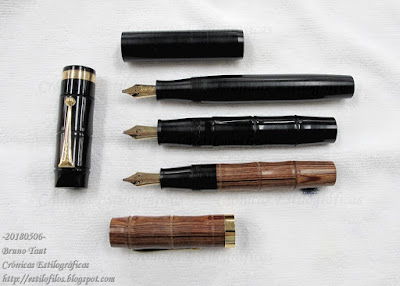The 65 was the first (::1::, ::2::, ::3::) of those anniversary pens that later became a regular model, albeit with some minor differences.
So, in the year 65 of the Pilot era, 1983, Pilot launched a limited edition of 6500 pens –6460 in black, 20 in red and 20 in blue— in the well-known balance shape that many insist in associating to Montblanc. Pilot’s argument is that it follows the style of some Pilot models produced in the 1920s and 1930s, which is undeniably true.
The Pilot 65 is made of plastic with a barleycorn finish, with a wide golden cap band with an intricate decoration. The nib is made of 14 K gold and its size is not marked—this was the first of the future Custom models with a whole new set of nibs. But in actual terms, the 65’s nib corresponded to a current size 10.
What is more interesting on this pen is the filling system—a captive CON-70 converter. Captive, I say, because it is built in the gripping section of the pen. This is, in fact, the first version of what later would become the CON-70 converter.
These are the dimensions of the Pilot 65 together with those of the Custom 67 and Custom 74, the natural evolutions of this anniversary pen:
| Pilot 65 | Custom 67 | Custom 74 | |
| Length closed (mm) | 140 | 142 | 143 |
| Length open (mm) | 126 | 125 | 126 |
| Length posted (mm) | 159 | 160 | 159 |
| Diameter (mm) | 13.5 | 14.0 | 14.6 |
| Weight (g) | 17.9 | 18.3 | 22.5 |
The Pilot 65, with its 6500 units, is now a well-sought after collectible pen. And that seems to be the fate of anniversary pens.
My thanks to Mr. NK.
Parker 50 – Sailor Tomikei Blue
Bruno Taut
Nakano, May 15th 2018
labels: Pilot, soluciones técnicas, conversor
Bruno Taut
Nakano, May 15th 2018
labels: Pilot, soluciones técnicas, conversor





















































